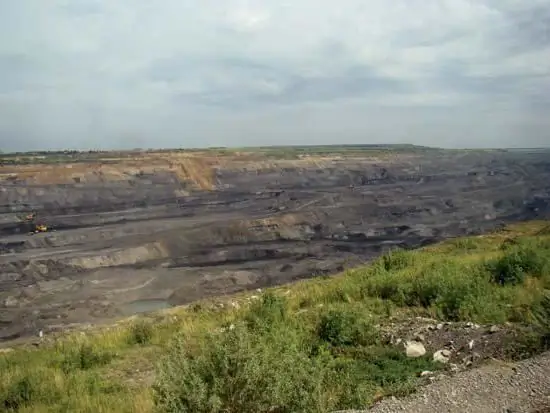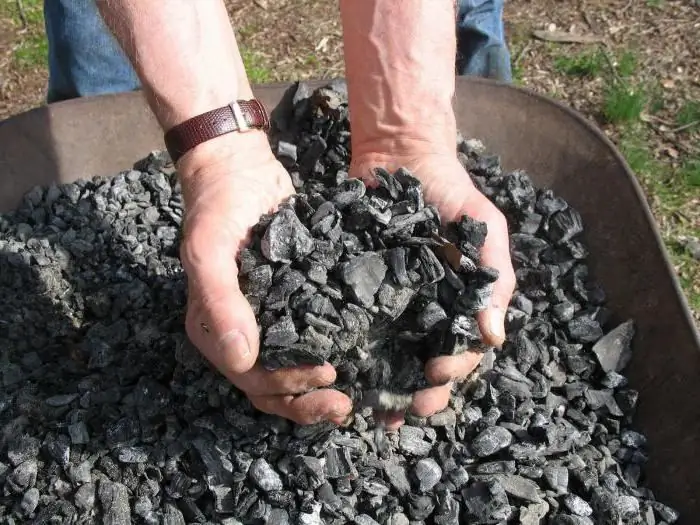2026 Author: Howard Calhoun | [email protected]. Last modified: 2025-06-01 07:12:56
The increase in oil prices and the search for alternative energy sources not only led to the development of new technologies, but drew attention to another, no less useful raw material - coal. The most important for the industry is coking coal. What is its value and where it is mined is described in this article.
What is coking coal
This is hard coal, from which coke of a certain strength and size is obtained under coking conditions. It is of great value to the industry and is in active demand in many industries. Thus, coking coal is used as the main fuel in the production of steel and energy.
Coking coals differ from other bituminous coals in their ability to go into a plastic state and sinter when exposed to high temperatures without oxygen.

Composition of coking coal
Coking coal in concentrated and unenriched form is characterized by low ash content (less than 10%), low content of volatile components (from 15 to 37%) and sulfur(less than 3.5%). Compared to other types of coal, coking coals have a high combustion temperature and are characterized by a lower content of impurities. The ratio of constituent substances in different coal deposits may vary slightly. This is very important to take into account in the process of its coking. So, before processing coal, its composition, coking capacity, caking capacity and other indicators are necessarily determined. On the territory of the post-Soviet space, the following types of coal are used for coking:
- K - coke.
- F - fat.
- G - gas.
- OS - lean-sintering.
- SS - highly caking.

Coking process
Coking is the technological process of converting coal into coke. It consists of several stages. At the first stage, the coal is prepared for coking. The mined coal is crushed and special mixtures are formed - charge. The next step is coking. It takes place in special chambers of a coke oven using gas heating. The prepared mixture is placed in the furnace for 15 hours, where all this time the temperature is raised to 1000ºС. The result of this process is a “coke cake.”
Coking technology has changed dramatically over the course of the twentieth century, allowing the development of new coal deposits.
According to estimates, about 10% of the world's hard coal production goes through the coking process. This fact confirms the high demand of the industry for cokingcoals.

What is the difference between coking and thermal coal
The greatest value for the industry is provided by coking coal, which is used as a process fuel in many industrial sectors of the national economy. For example, for iron smelting. The main feature that distinguishes coking coal from power coal is the presence of a vitren. This is the ash component of coal, which is formed as a result of the decomposition of plants in the absence of oxygen. The properties of vitren are the ability to melt and sinter under the influence of high temperature. Thus, the microparticles of coal stick together into one dense mass. The higher the concentration of vitren, the higher the quality of coking of such coal.
The largest amount of fusible substances is contained in such grades of coal: coke, gas, fatty, lean-caking and coke fat.
Coal grades

In nature, there are many varieties of coal, which differ in technical composition, sintering performance and volatile components. Only a few grades of coal are suitable for coking. But not all of them are suitable for sintering in their pure form. Sometimes some components need to be added. So, there are the following grades of coking coal:
- K - coke. When coking this brand of coal in its pure form, standard metallurgical coke is obtained. To obtain the highest quality coal, other grades are added - bold orgas.
- KZh - coke fat. It has the best coking ability, it is mainly used to produce coke without adding other grades of coal. The composition of coke fat coal contains up to 30% of volatile components. Vitren reflection - 1.3%. The thickness of the plastic layer is 18 mm. Without changing the quality of coke, it is allowed to add up to 20% of CS, OS and KO to this brand.
- KO - coke lean. The layer thickness is 10-12 mm, the vitren reflection is up to 1%. As a rule, this brand is not used separately, but only in combination with ZhK and GZh coal.
- KSN - coke low-caking low-metamorphosis. During sintering, this type of coal produces a washable coke with low strength, so it is mainly used for sintering with other grades or for producing syngas.
- KS - low-caking coke. The thickness of the plastic layer is up to 9 mm. Characterized by low sintering. Coal grade KS is used by coke enterprises as a lean component. It is also used in some areas of production for layered combustion.
- GK - gas coking. Coking gives well-fused coke, but with low mechanical strength. The sintered product is easily divided into small pieces. Usually gas coal is used in mixtures with other coking coals.
The following grades of coking coal are considered to be the best for sintering: fatty, slightly caking, gas, lean-sintering and coke in its pure form. They contain the least amount of impurities, and they have a highplasticity.
Application areas
The main purpose of coking coal is industrial fuel. During combustion, coking coal releases a large amount of heat energy. So, the ignition temperature of this fuel is 470ºС. But burning is not the only way to extract useful properties from this fossil. There are many other sectors of the national economy that effectively use coking coal. The use of this natural resource in industrial processes makes it possible to obtain lead, molybdenum, zinc, germanium, sulfur, gallium and other chemical elements from it. Wastes from the coal industry also have industrial applications. So, they are processed into refractory materials and abrasives. Construction materials are also produced from waste.
In total, more than 300 varieties of products are made from stone fuel. Coal is used as the main material for the production of carbon-graphite structural elements, high-nitric acids, which are used in fertilizers. Substances that are released during the coking process have an effective application. So, during dry distillation, coal tar and ammonia water are formed. They are also recyclable.
In addition, coking produces gaseous products that contain benzene, phenol, ammonia and toluene. They serve as sources of other beneficial substances.

Coking coal production in Ukraine
Coking coal in Ukraine is mainly usedmetallurgical enterprises. Thus, metallurgy accounts for about 90% of the total demand for this type of fuel. The extractive industry of the country supplies coking coal to the domestic market by only 60%. The remaining 40% of coal consumed is imported. Russia is the main supplier of coking coal to Ukraine.
In recent years, the country has seen an increase in demand for foreign raw materials. This is due to the decline in domestic production. Also, the demand for domestic raw materials is falling due to a decrease in its quality, since metallurgical plants cannot use coal with a high sulfur content.
In Ukraine, coking coal is mined in the basins: Donetsk, Lvov-Volyn, Dnieper. The largest amount of coal reserves is concentrated in the Donetsk, Luhansk and Dnepropetrovsk regions. At the moment, due to political instability, the production of coking coal in eastern Ukraine has been suspended.

Coal mining in Russia
In Russia there are large deposits of coal. According to the figures, the country occupies one of the first places in the world in terms of coal reserves. More than 67% of them are hard coal. Of these, 10% are coking coals.
In Russia, coking coal is mined in the basins: Kuznetsk, Pechora, Yuzhno-Yakutsk, Donetsk and Kizelovsk. The first two basins produce the most coal.
Coking coal reserves in the Russian Federation amount to 47.3 billion tons. However, only a small part is usable. ATIn recent years, the production of coking coal in Russia has been at the level of 70 million tons per year. This is enough to provide the country's industrial enterprises with raw materials.
Coking coal in Russia is mined at a stable pace. An increase in coal production will take place in the event of an increase in demand for this type of raw material, due to the development of metallurgical and related sectors of the Russian economy.
Coking coal market outlook
In the coming years, the Russian coal industry is waiting for changes. Key areas of development of the industry will relate to the vertical system of coal production. Thus, state policy provides for the creation of energy facilities of small and medium capacity on the basis of coal mines. It is also planned to install equipment at coal-mining enterprises that allows processing coal into environmentally friendly synthetic fuels.
In terms of sales volumes, demand for coking coal in Russia will grow. The fact is that in addition to steel mills, non-ferrous metallurgy and many other industries use coke. So, for the production of 1 ton of pig iron, about 0.4 tons of coke is needed. And alternative technologies that allow it to be replaced by a more profitable resource are used to a limited extent.

Trends in the global coking coal market
Today, many coal companies of all countries are experiencing a crisis of lower prices for coking coal. This problem is exacerbated by states that supply coke in excess quantities. Also, the desire of buyers to reduce costs has a great influence on prices. Another unfavorable situation arises from the desire of steel producers to reduce production costs. In Europe and China, demand for coking coal continues to grow, but this is at the expense of higher-end products. But in general, the volume of purchases of raw materials on the world market is falling.
Slightly stabilized the situation with energy raw materials in the US market. But the price of it continues to fall due to lower demand for steel. As a result, coking coal production in the US and Europe may be reduced.
But experts predict an increase in imports of energy raw materials in India. In terms of imports of coking coal, this country ranks third in the world.
Price of raw materials
In the second quarter of 2015 there is a decrease in prices for coking coal. Large global companies offer raw materials at a price that is 5-10% lower compared to the first quarter. Thus, the South African company Anglo American offered Japan the highest quality coking coal at $116 per 1 ton. The average price for 1 ton of coking coal is $117.
Recommended:
Moscow region coal basin - history, features and interesting facts

Mining is an industry that has been developing for a very, very long time. One of the rather old deposits is the Podmoskovny coal basin
Coal: mining in Russia and in the world. Places and methods of coal mining

The coal mining industry is the largest segment of the fuel industry. Every year, the level of coal production increases all over the world, new technologies are mastered, equipment is improved
Brown coal. Coal mining. Brown coal deposit

The article is about brown coal. The features of the rock, the nuances of production, as well as the largest deposits are considered
Delayed coking unit: project, operating principle, power calculation and raw materials

Delayed coking unit: principle of operation, raw materials and finished products. Description of different types of equipment. Schematic diagram of a two-block plant, main technological parameters. Design sequence and power calculation
Coal: properties. Hard coal: origin, production, price

Since ancient times, mankind has been using coal as one of the sources of energy. And today this mineral is used quite widely

